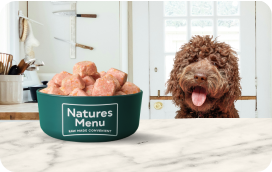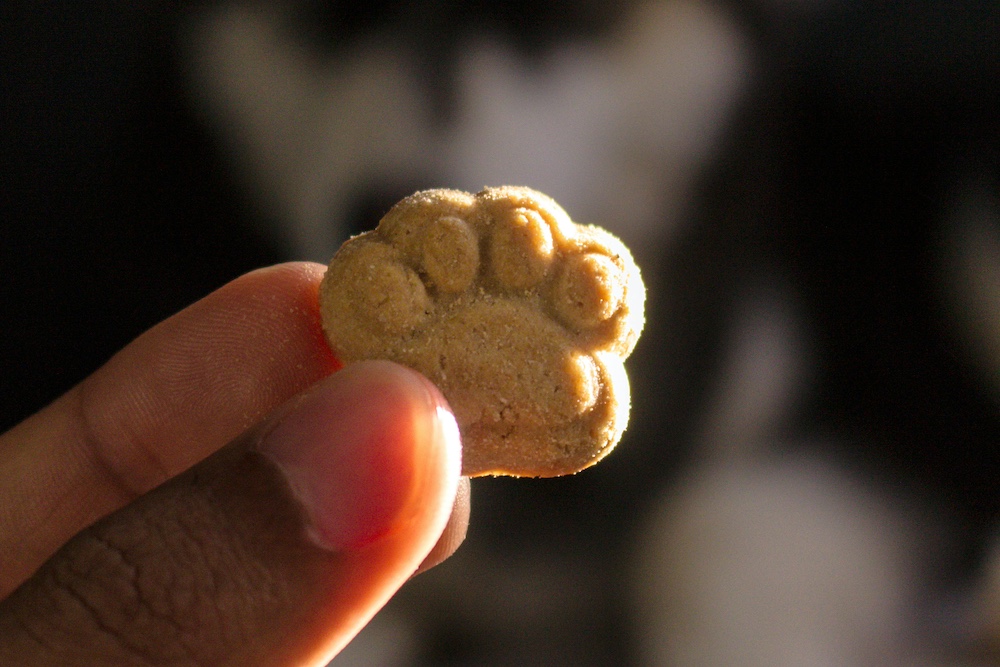Quick takeaways about common dog food ingredients
- Crude ash relates to the mineral content in dog food – it’s not actual ash!
- The meat content in dog food varies hugely – food that’s ‘meat-flavoured’ doesn’t have to contain any meat at all.
- Some dog food manufacturers use more cheap, processed cereals and less meat to keep costs down.
- Artificial colours and preservatives have been linked to digestive problems and long-term health issues in dogs and other animals.
Confused about crude ash? Baffled by meat and moisture content? You’re not alone – choosing the right dog food for your pooch can be overwhelming, with so many options, ingredients and formats out there.
One simple thing you can do is check the ingredients list. This will quickly help you understand the quality of the dog food and whether it contains ingredients like colours, fillers, and additives – providing no nutritional value at best, and potentially harming your dog’s health at worst.
Here, we ask leading veterinarian and raw food advocate Dr Nick Thompson to break down some common ingredients in dry, wet and raw foods, including the good, the bad and the very ugly.
Common dog food ingredients: The good
Raw dog food tends to have higher-quality whole ingredients compared to ultra-processed dry or wet foods.
Besides raw meat, bone and organ meats, there are a few common ingredients you might not recognise but are there for good reason.
Complete vs complementary
Some dog foods are marketed as ‘complete’ and contain all the nutrients, vitamins, and minerals your dog needs (like our Complete and Balanced Raw). Other foods might be labelled ‘complementary’, meaning they should be given to your dog with other foods to make a more complete diet.
Bone
Some types of raw dog food contain bone, and in Dr Nick’s opinion, this is essential for healthy dogs. “Bone is good for dogs in several ways,” he says. “One is that big, chunky recreational bones are good for chewing, keeping your dog occupied and helping to clean their teeth.
“Bones also offer important minerals like calcium, which can also balance the phosphorus in the meat (a healthy balance of both is crucial to ensure a dog's healthy skeletal development).
“Bone is fibre, so it’s a great natural prebiotic for your dog’s gut microbiome. It also has a scouring effect on the gut, which is good for forming healthy poos. There’s a phrase: ‘Bone binds and liver loosens,’ which I quite like.”
Tripe and offal
These are known as organ meats and include everything from the heart and liver, to the kidney and spleen. But don’t be put off; these ingredients are so good for your dog. “There are more nutrients in organ meats than muscle meats,” says Dr Nick.
“Dogs have been around for between 45-65 million years, and what have they been eating? Anything they can get hold of! If a hyena pack takes down an antelope, they will eat the entire thing – the skin, eyes, tongue, neck, heart, lungs, you name it.”
We’ve all been a bit sanitised to organ meats over the years, and yet they can be the richest source of vital vitamins and minerals, from iron to B vitamins.
Crude ash
No, this doesn’t mean there’s ash in your dog’s food. Crude ash – also known as ‘inorganic matter’ or ‘incinerated residue’ – measures the mineral content in dog food, like calcium, phosphorus and magnesium.
“It’s referred to as ash because the mineral content is what’s left if the rest of the food – carbon and hydrogen elements – were burnt off,” explains Dr Nick. Strange but true.
Water content
The moisture content in dog food relates to how much water is in the food. It doesn’t mean that water has been added in, it’s more a reflection of the natural moisture content of the food.
Unsurprisingly, moisture will help to keep your dog hydrated, but it also helps with digestion because they use saliva and stomach acid to break down food.
According to UK Pet Food, dry dog food only contains about 4 to 10% moisture, so a dog will need to drink more water on a dry diet. Wet food is made up of around 70-80% water, and raw foods have a natural moisture content of around 65%.
Common dog food ingredients: The bad
In lower-quality dry and wet foods, cheaper filler ingredients start to creep in, and you might notice a longer list and items you wouldn’t recognise.
Meat vs meat meal
“Meat is animal muscle. Meat meal is the leftover stuff that some big food brands blast off animal carcasses, including skin, ears, testicles, plastic ear tags, beaks, feathers, and farmyard waste,” says Dr Nick. “It’s added to a giant vat and stewed for hours, at high temperatures, and it produces a vile soup.
“They evaporate off the liquid, leaving a dry lump. This is then crushed and ground into meat and bone meal. It often includes microplastics and a lot of other unidentifiable stuff – it’s pretty stomach-churning.”
Meat flavouring
With lower-quality dog foods, it can be hard to tell the percentage of actual meat, especially with phrases like ‘chicken dinner/formula,’ ‘dog food with chicken’, and ‘dog food with chicken flavour’.
Dog food that says it is made ‘with’ chicken or any other meat must contain at least 4% of that meat. However, a dog food that states it’s ‘chicken-flavoured’ doesn’t have to contain any at all, which can be very misleading!
Animal digest or meat derivatives
These vague-sounding ingredients are very low-quality, and there’s little to no regulation of the meat quality used to make them. It could be healthy muscle tissue or an animal by-product from a less desirable source. For dogs with food allergies, it’s best to avoid them as you can never be sure which ingredients are included.
“Animal digest can be that kind of soup that comes off boiled down, or chemically or enzymatically rendered animal carcasses,” says Dr Nick.
“Ultra-processed food brands add it to pet food to make it more palatable – because as you can imagine, before they start enhancing the flavour of these foods, they’ll be bland or unpalatable – as are many ultra-processed foods before the flavourings department gets hold of them.”
Common dog food ingredients: The ugly
The ugly truth is that many low-quality dog foods contain ultra-processed ingredients that can damage your dog’s health in the long-run.
Fillers, preservatives and additives can damage and disrupt balances in the body, especially the gut. “In some dog foods, you might notice a tirade of additives and emulsifiers, which can disrupt the gut microbiome,” explains Dr Nick.
“So, whenever you're looking at your dog’s food, you're also looking at the direct effect of that food on their body, metabolism and also on the population of good bacteria in their gut.”
Fillers
These vague-sounding ingredients are very low-quality, and there’s little to no regulation of the meat quality used to make them. It could be healthy muscle tissue or an animal by-product from a less desirable source. For dogs with food allergies, it’s best to avoid them as you can never be sure which ingredients are included.
“Animal digest can be that kind of soup that comes off boiled down, or chemically or enzymatically rendered animal carcasses,” says Dr Nick.
“Ultra-processed food brands add it to pet food to make it more palatable – because as you can imagine, before they start enhancing the flavour of these foods, they’ll be bland or unpalatable – as are many ultra-processed foods before the flavourings department gets hold of them.”
Processed grains and cereals
Dogs don’t need either of these in their diet – though healthy grains like brown rice can be helpful in some dogs. Other common cereals in dog food include wheat, oats and barley. Some brands are made up of around 70% unspecified ‘cereal’, making the recipe vague and not so nutritious for your pup and potentially allergenic, creating gut or skin issues.
You might also see ingredients like maize or rice flour, potato starch, soy, wheat germ (which is the indigestible element of the cereal) or rice bran (a byproduct with far less nutritional value than whole rice).
Processed cereals and starches like these fit in the ugly category – they don’t bring much to the table nutritionally, and research proves they can put unnecessary strain on your dog’s digestive system.
It all comes down to keeping food cheap. “The ultra-processed corporations put in cereals because they can buy thousands of tons at a time. Soy, wheat and corn are cheaper than meat, Why fill a bag of kibble with meat when you can fill it with cereal for a fraction of the price?”
Thickeners, gums and gelling agents
Some types of wet dog food (especially patés) need special thickeners and gelling agents to bind the ingredients together and give the food its firm texture.
Look out for gelling agents like agar-agar and carrageenan, as well as thickeners like xanthan gum or locust bean gum. Plenty of studies have linked them to digestive issues. This is not surprising, as xanthan gum is made from bacterial slime.
Artificial additives and preservatives
Additives in dog food are substances intentionally added to the food to serve a specific function. They might enhance the nutritional content, flavour, texture, appearance or shelf-life of the dog food.
Artificial colours
“Some manufacturers will use colours like caramel to make kibble look more appealing to dog owners,” explains Dr Nick. “When you mass-produce meat products, they’re pretty grey, so caramel can give them a rich, brown colour.
“In the long-term, ingredients like this can be toxic; they give no nutritional value and are linked to allergies and sensitivities in dogs.”
High fructose corn syrup
“This is a common ingredient in human ultra-processed foods,” says Nick. It’s sometimes added to dog food to make it taste better. “We now know from plenty of human, as well as dog research, that eating a high proportion of sugary foods is linked to obesity and diabetes.”
Preservatives
BHA (butylated hydroxyanisole), BHT (butylated hydroxytoluene) and ethoxyquin are artificial preservatives that are usually added to extend the shelf life of dog food. Brands refer to them as antioxidants. However, they’ve been linked to health problems in dogs.
A study by the University of Hamburg concluded that BHA and BHT are ‘tumour promoters’ – which means they increase the risk of cancerous tumours.
Another common preservative, potassium sorbate, could cause skin, eye and respiratory issues and has been shown to damage white blood cells, according to another study.
The final say
Always check the ingredient list to ensure you’re providing the best diet for your dog. Look for foods that list high-quality proteins, like beef, chicken, turkey or salmon, as the main ingredients and swerve those that contain fillers and artificial additives. Check the dog food ingredient glossary by All About Dog Food if in doubt.
High-quality, raw dog food is an excellent option if you want to feed your dog a simple, nutritious, minimally processed diet. “The ingredients list is usually short, and you won’t find any of the nasty ingredients mentioned above,” says Dr Nick.
“If you’re currently feeding dry and want to switch – start with a complete and balanced raw option while you and your dog get used to the new diet. In my opinion, it’s the best diet for your dog’s health and wellbeing, working with their body instead of against it.”
About Dr Nick
Dr Nick has been a veterinarian for 30+ years and runs Holistic Vet practice. He is a passionate canine raw food advocate and an expert in natural dog nutrition. He shares his knowledge with dog owners and experts across the world.








